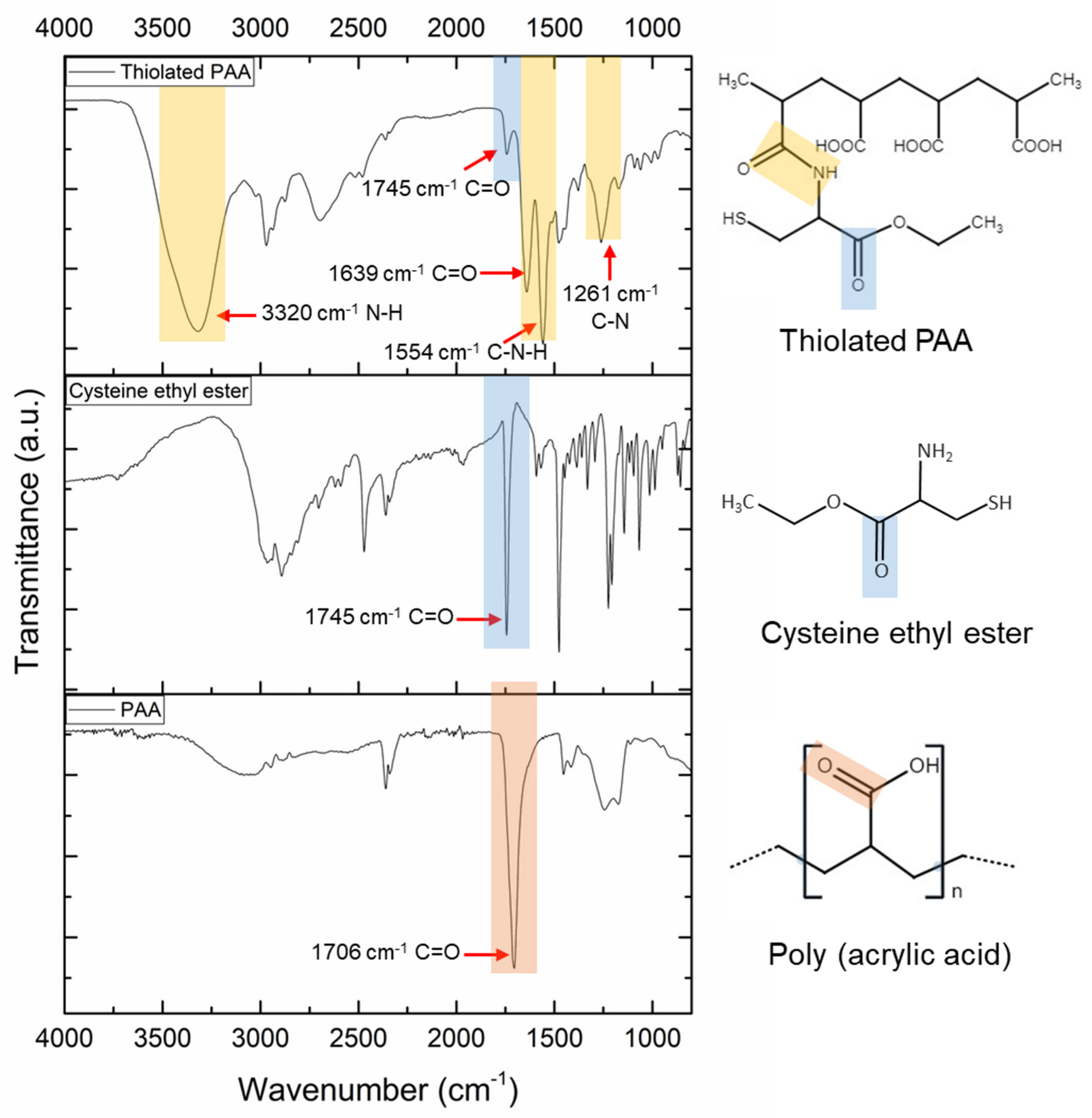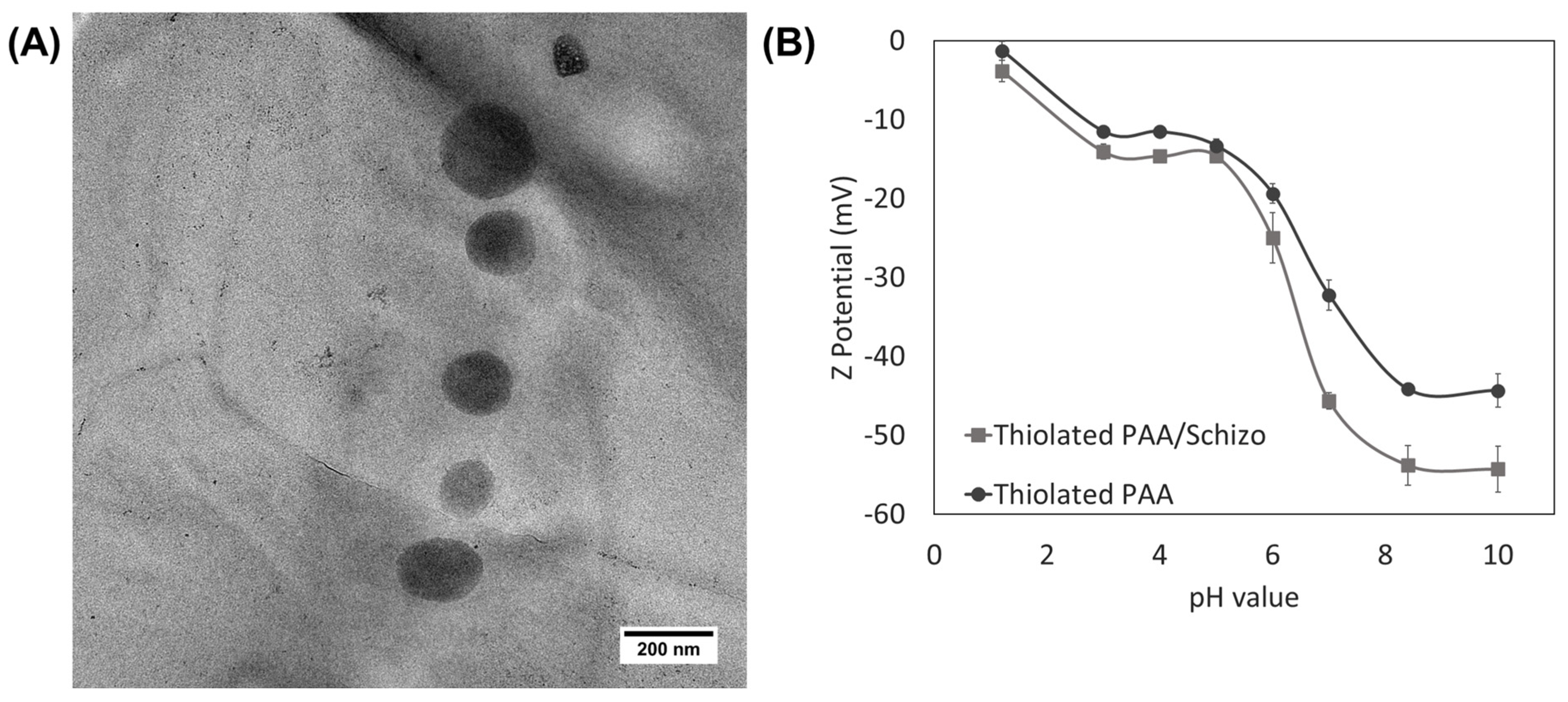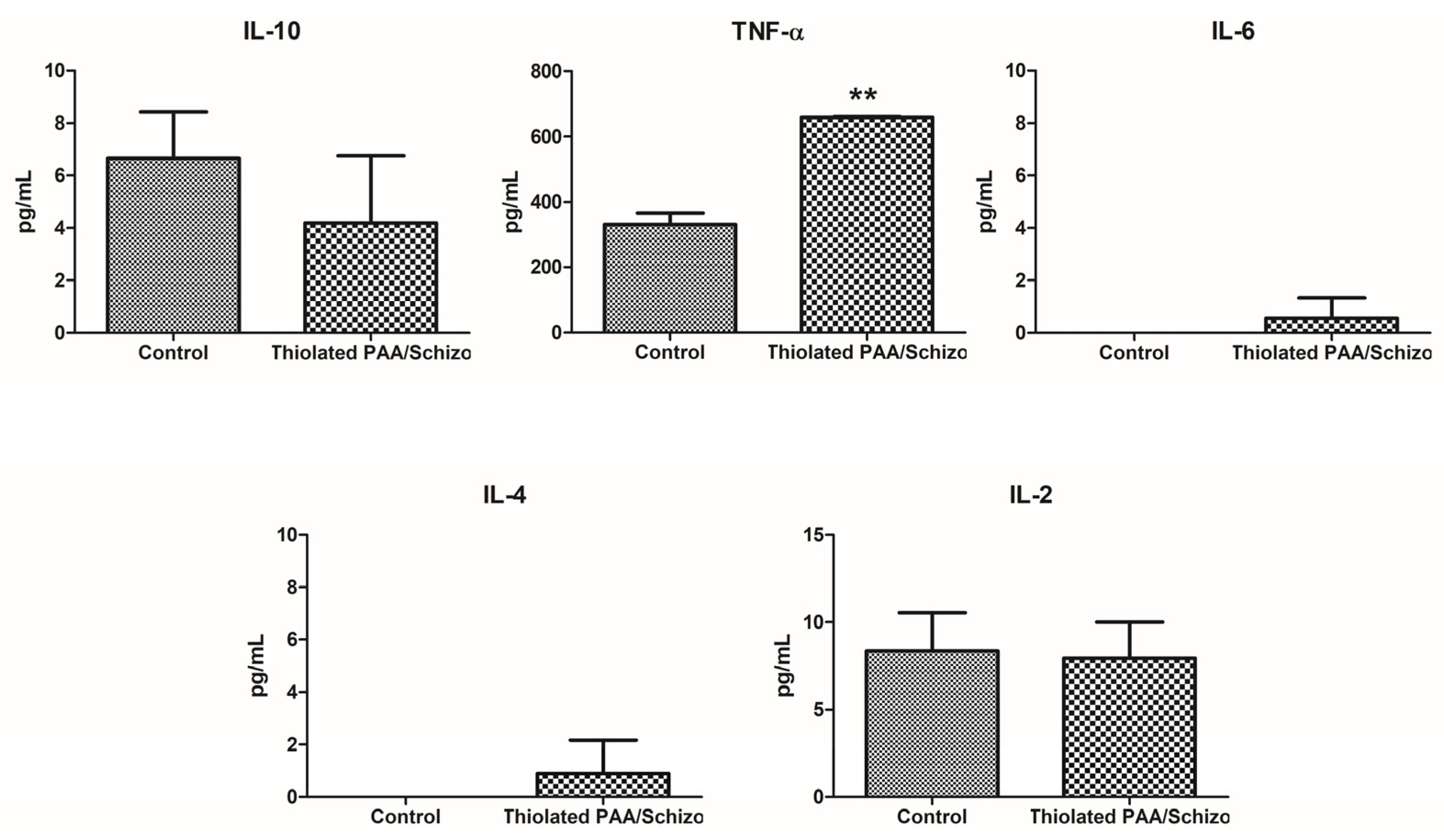Synthesis and Characterization of Thiolated Nanoparticles Based on Poly (Acrylic Acid) and Algal Cell Wall Biopolymers for the Delivery of the Receptor Binding Domain from SARS-CoV-2
Abstract
:1. Introduction
2. Materials and Methods
2.1. Cell Wall Fraction (CWF) Isolation
2.2. Synthesis of Thiolated Polyacrylic Acid (Thiolated PAA)
2.3. Determination of Thiol and Disulfide Groups
2.4. Determination of Amino Groups
2.5. Synthesis of Thiolated PAA/Schizo Particles
2.6. Characterization of Thiolated PAA/Schizo Particles
2.6.1. Fourier Transform Infrared Spectroscopy
2.6.2. Hydrodynamic Diameter and Zeta Potential Measurement
2.6.3. Transmission Electron Microscopy (TEM)
2.6.4. Thermogravimetric Analysis
2.7. In Vitro Mucoadhesiveness
2.8. In Vitro Cell Viability
2.9. Cytokine Immune Assay
2.10. RBD-Loaded Thiolated PAA/Schizo Particles
2.11. Immunogenicity Assessment
2.12. Enzyme-Linked Immunosorbent Assay (ELISA)
2.13. Statistical Analysis
3. Results and Discussion
3.1. Synthesis and Characterization of Thiolated PAA
3.2. Characterization of Thiolated PAA/Schizo Particles
3.3. In Vitro Mucoadhesiveness
3.4. Cytotoxicity of Thiolated PAA/Schizo Particles
3.5. Effect of Thiolated PAA/Schizo Particles on Cytokine Production
3.6. RBD-Thiolated PAA/Schizo Particles Humoral Immune Assessment
4. Conclusions
Author Contributions
Funding
Institutional Review Board Statement
Informed Consent Statement
Data Availability Statement
Acknowledgments
Conflicts of Interest
References
- Anderson, R.M. The impact of vaccination on the epidemiology of infectious diseases. In The Vaccine Book; Bloom, B.R., Lambert, P.H., Eds.; Academic Press: Cambridge, MA, USA, 2016; pp. 3–31. [Google Scholar]
- Gunn, B.M.; Alter, G. Modulating antibody functionality in infectious disease and vaccination. Trends Mol. Med. 2016, 22, 969–982. [Google Scholar] [CrossRef] [PubMed]
- Heidary, M.; Kaviar, V.H.; Shirani, M.; Ghanavati, R.; Motahar, M.; Sholeh, M.; Ghahramanpour, H.; Khoshnood, S. A comprehensive review of the protein subunit vaccines against COVID-19. Front. Microbiol. 2022, 13, 927306. [Google Scholar] [CrossRef] [PubMed]
- Chavda, V.P.; Hossain, M.K.; Beladiya, J.; Apostolopoulos, V. Nucleic acid vaccines for COVID-19: A paradigm shift in the vaccine development arena. Biologics 2021, 1, 337–356. [Google Scholar] [CrossRef]
- Bobbala, S.; Hook, S. Is there an optimal formulation and delivery strategy for subunit vaccines? Pharm. Res. 2016, 33, 2078–2097. [Google Scholar] [CrossRef] [PubMed]
- Singh, S.; Möller, M.; Pich, A. Biohybrid nanogels. J. Polym. Sci. Part A Polym. Chem. 2013, 51, 3044–3057. [Google Scholar] [CrossRef]
- Ramos-Vega, A.; Rosales-Mendoza, S.; Bañuelos-Hernández, B.; Angulo, C. Prospects on the use of Schizochytrium sp. to develop oral vaccines. Front. Microbiol. 2018, 9, 353095. [Google Scholar] [CrossRef] [PubMed]
- Mousaviasl, S.; Saleh, T.; Shojaosadati, S.A.; Boddohi, S. Synthesis and characterization of schizophyllan nanogels via inverse emulsion using biobased materials. Int. J. Biol. Macromol. 2018, 120, 468–474. [Google Scholar] [CrossRef] [PubMed]
- Duggan, S.; Cummins, W.; O’Donovan, O.; Hughes, H.; Owens, E. Thiolated polymers as mucoadhesive drug delivery systems. Eur. J. Pharm. Sci. 2017, 100, 64–78. [Google Scholar] [CrossRef] [PubMed]
- Ding, P.; Liu, H.; Zhu, X.; Chen, Y.; Zhou, J.; Chai, S.; Wang, A.; Zhang, G. Thiolated chitosan en-capsulation constituted mucoadhesive nanovaccine confers broad protection against divergent influenza A viruses. Carbohydr. Polym. 2024, 328, 121689. [Google Scholar] [CrossRef]
- Arkaban, H.; Barani, M.; Akbarizadeh, M.R.; Pal Singh Chauhan, N.; Jadoun, S.; Dehghani Soltani, M.; Zarrintaj, P. Polyacrylic acid nanoplatforms: Antimicrobial, tissue engineering, and cancer theranostic applications. Polymers 2022, 14, 1259. [Google Scholar] [CrossRef]
- García-Silva, I.; Olvera-Sosa, M.; Ortega-Berlanga, B.; Ruíz-Rodríguez, V.; Palestino, G.; Rosales-Mendoza, S. Synthesis and characterization of innovative microgels based on polyacrylic acid and microalgae cell wall and their potential as antigen delivery vehicles. Pharmaceutics 2022, 15, 133. [Google Scholar] [CrossRef] [PubMed]
- Glass, J.J.; Li, Y.; De Rose, R.; Johnston, A.P.R.; Czuba, E.I.; Khor, S.Y.; Quinn, J.F.; Whittaker, M.R.; Davis, T.P.; Kent, S.J. Thiol-Reactive Star Polymers Display Enhanced Association with Distinct Human Blood Components. ACS Appl. Mater. Interfaces 2017, 9, 12182–12194. [Google Scholar] [CrossRef] [PubMed]
- Srivastava, A.; Verma, A.; Saraf, S.; Jain, A.; Tiwari, A.; Panda, P.K.; Jain, S.K. Mucoadhesive gastroretentive microparticulate system for programmed delivery of famotidine and clarithromycin. J. Microencapsul. 2021, 38, 151–163. [Google Scholar] [CrossRef] [PubMed]
- Zhao, Y.; Li, Y.; Ge, J.; Li, N.; Li, L.B. Pluronic-poly (acrylic acid)-cysteine/Pluronic L121 mixed micelles improve the oral bioavailability of paclitaxel. Drug Dev. Ind. Pharm. 2014, 40, 1483–1493. [Google Scholar] [CrossRef] [PubMed]
- Greindl, M.; Bernkop-Schnürch, A. Development of a novel method for the preparation of thiolated polyacrylic acid nanoparticles. Pharm. Res. 2006, 23, 2183–2189. [Google Scholar] [CrossRef]
- Bernkop-Schnürch, A.; Schwarz, V.; Steininger, S. Polymers with thiol groups: A new generation of mucoadhesive polymers? Pharm. Res. 1999, 16, 876–881. [Google Scholar] [CrossRef]
- Habeeb, A.F.S.A. A sensitive method for localization of disulfide containing peptides in column effluents. Anal. Biochem. 1973, 56, 60–65. [Google Scholar] [CrossRef]
- Cisneros-Covarrubias, C.A.; Palestino, G.; Gómez-Durán, C.F.; Rosales-Mendoza, S.; Betancourt-Mendiola, M. de Lourdes. Optimized microwave-assisted functionalization and quantification of superficial amino groups on porous silicon nanostructured microparticles. Anal. Methods 2021, 13, 516–525. [Google Scholar] [CrossRef]
- Gök, M.K.; Demir, K.; Cevher, E.; Özsoy, Y.; Cirit, Ü.; Bacınoğlu, S.; Özgümüş, S.; Pabuccuoğlu, S. The effects of the thiolation with thioglycolic acid and l-cysteine on the mucoadhesion properties of the starch-graft-poly (acrylic acid). Carbohydr. Polym. 2017, 163, 129–136. [Google Scholar] [CrossRef]
- Dong, J.; Ozaki, Y.; Nakashima, K. Infrared, Raman, and near-infrared spectroscopic evidence for the coexistence of various hydrogen-bond forms in poly (acrylic acid). Macromolecules 1997, 30, 1111–1117. [Google Scholar] [CrossRef]
- Moharram, M.A.; Rabie, S.M.; El-Gendy, H.M. Infrared spectra of γ-irradiated poly (acrylic acid)–polyacrylamide complex. J. Appl. Polym. Sci. 2002, 85, 1619–1623. [Google Scholar] [CrossRef]
- Devi, S.; Singh, B.; Paul, A.K.; Tyagi, S. Highly sensitive and selective detection of trinitrotoluene using cysteine-capped gold nanoparticles. Anal. Methods 2016, 8, 4398–4405. [Google Scholar] [CrossRef]
- Marschütz, M.K.; Bernkop-Schnürch, A. Thiolated polymers: Self-crosslinking properties of thiolated 450 kDa poly (acrylic acid) and their influence on mucoadhesion. Eur. J. Pharm. Sci. 2002, 15, 387–394. [Google Scholar] [CrossRef]
- Guggi, D.; Marschütz, M.K.; Bernkop-Schnürch, A. Matrix tablets based on thiolated poly (acrylic acid): pH-dependent variation in disintegration and mucoadhesion. Int. J. Pharm. 2004, 274, 97–105. [Google Scholar] [CrossRef]
- Grießinger, J.A.; Bonengel, S.; Partenhauser, A.; Ijaz, M.; Bernkop-Schnürch, A. Thiolated polymers: Evaluation of their potential as dermoadhesive excipients. Drug Dev. Ind. Pharm. 2017, 43, 204–212. [Google Scholar] [CrossRef]
- Grabovac, V.; Laffleur, F.; Bernkop-Schnürch, A. Thiomers: Influence of molecular mass and thiol group content of poly (acrylic acid) on efflux pump inhibition. Int. J. Pharm. 2015, 493, 374–379. [Google Scholar] [CrossRef] [PubMed]
- Bonengel, S.; Haupstein, S.; Perera, G.; Bernkop-Schnürch, A. Thiolated and S-protected hydrophobically modified cross-linked poly (acrylic acid)–a new generation of multifunctional polymers. Eur. J. Pharm. Biopharm. 2014, 88, 390–396. [Google Scholar] [CrossRef] [PubMed]
- Dünnhaupt, S.; Barthelmes, J.; Köllner, S.; Sakloetsakun, D.; Shahnaz, G.; Düregger, A.; Bernkop-Schnürch, A. Thiolated nanocarriers for oral delivery of hydrophilic macromolecular drugs. Carbohydr. Polym. 2015, 117, 577–584. [Google Scholar] [CrossRef]
- Qu, L.; Ren, L.J.; Li, J.; Sun, G.N.; Sun, L.N.; Ji, X.J.; Nie, Z.K.; Huang, H. Biomass composition, lipid characterization, and metabolic profile analysis of the fed-batch fermentation process of two different docosahexanoic acid producing Schizochytrium sp. strains. Appl. Biochem. Biotechnol. 2013, 171, 1865–1876. [Google Scholar] [CrossRef]
- Liu, Y.; Singh, P.; Sun, Y.; Luan, S.; Wang, G. Culturable diversity and biochemical features of thraustochytrids from coastal waters of Southern China. Appl. Microbiol. Biotechnol. 2014, 98, 3241–3255. [Google Scholar] [CrossRef]
- Ghazali, N.A.B.; Mani, M.P.; Jaganathan, S.K. Green-synthesized zinc oxide nanoparticles decorated nanofibrous polyurethane mesh loaded with virgin coconut oil for tissue engineering application. Curr. Nanosci. 2018, 14, 280–289. [Google Scholar] [CrossRef]
- Bigon, J.P.; Montoro, F.E.; Lona, L.M. Vegetable Oils Acting as Encapsulated Bioactives and Costabilizers in Miniemulsion Polymerization Reactions. Eur. J. Lipid Sci. Technol. 2018, 120, 1700130. [Google Scholar] [CrossRef]
- Garay, M.T.; Alava, C.; Rodriguez, M. Study of polymer–polymer complexes and blends of poly (N-isopropylacrylamide) with poly (carboxylic acid). 2. Poly (acrylic acid) and poly (methacrylic acid) partially neutralized. Polymer 2000, 41, 5799–5807. [Google Scholar] [CrossRef]
- Maddi, B.; Vadlamani, A.; Viamajala, S.; Varanasi, S. Quantification of Lipid Content in Oleaginous Biomass Using Thermogravimetry. In Microbial Lipid Production; Balan, V., Ed.; Humana Press: New York, NY, USA, 2019; pp. 121–129. [Google Scholar]
- Sarti, F.; Iqbal, J.; Müller, C.; Shahnaz, G.; Rahmat, D.; Bernkop-Schnürch, A. Poly (acrylic acid)–cysteine for oral vitamin B12 delivery. Anal. Biochem. 2012, 420, 13–19. [Google Scholar] [CrossRef] [PubMed]
- Pornpitchanarong, C.; Rojanarata, T.; Opanasopit, P.; Ngawhirunpat, T.; Patrojanasophon, P. Preactivated-thiolated polyacrylic acid/1-vinyl pyrrolidone nanoparticles as nicotine carriers for smoking cessation. RSC Adv. 2020, 10, 33517–33525. [Google Scholar] [CrossRef]
- Mohamadi, P.S.; Hivechi, A.; Bahrami, H.; Hemmatinegad, N.; Milan, P.B. Antibacterial and biological properties of coconut oil loaded poly (ε-caprolactone)/gelatin electrospun membranes. J. Ind. Text. 2022, 51, 906S–930S. [Google Scholar] [CrossRef]
- Karamanlioglu, M.; Yesilkir-Baydar, S. Production and characterization of a coconut oil incorporated gelatin-based film and its potential biomedical application. Biomed. Mater. 2022, 17, 045014. [Google Scholar] [CrossRef] [PubMed]
- Wajant, H.; Pfizenmaier, K.; Scheurich, P. Tumor necrosis factor signaling. Cell Death Differ. 2003, 10, 45–65. [Google Scholar] [CrossRef] [PubMed]
- Scheller, J.; Chalaris, A.; Schmidt-Arras, D.; Rose-John, S. The pro-and anti-inflammatory properties of the cytokine interleukin-6. Biochim. Biophys. Acta (BBA)-Mol. Cell Res. 2011, 1813, 878–888. [Google Scholar] [CrossRef]
- Li, P.; Song, H.; Zhang, H.; Yang, P.; Zhang, C.; Huang, P.; Kong, D.; Wang, W. Engineering biodegradable guanidyl-decorated PEG-PCL nanoparticles as robust exogenous activators of DCs and antigen cross-presentation. Nanoscale 2017, 9, 13413–13418. [Google Scholar] [CrossRef]
- Gong, H.; Xiang, J.; Xu, L.; Song, X.; Dong, Z.; Peng, R.; Liu, Z. Stimulation of immune systems by conjugated polymers and their potential as an alternative vaccine adjuvant. Nanoscale 2015, 7, 19282–19292. [Google Scholar] [CrossRef] [PubMed]
- Pulendran, B.; Arunachalam, S.P.; O’Hagan, D.T. Emerging concepts in the science of vaccine adjuvants. Nat. Rev. Drug Discov. 2021, 20, 454–475. [Google Scholar] [CrossRef] [PubMed]
- Luchner, M.; Reinke, S.; Milicic, A. TLR agonists as vaccine adjuvants targeting cancer and infectious diseases. Pharmaceutics. 2021, 13, 142. [Google Scholar] [CrossRef] [PubMed]
- Min, L.; Sun, Q. Antibodies and vaccines target RBD of SARS-CoV-2. Front. Mol. Biosci. 2021, 8, 671633. [Google Scholar] [CrossRef] [PubMed]
- Patnaik, S.; Gorain, B.; Padhi, S.; Choudhury, H.; Gabr, G.A.; Md, S.; Mishra, D.K.; Kesharwani, P. Recent update of toxicity aspects of nanoparticulate systems for drug delivery. Eur. J. Pharm. Biopharm. 2021, 161, 100–119. [Google Scholar] [CrossRef] [PubMed]
- Shi, S.; Zhu, H.; Xia, X.; Liang, Z.; Ma, X.; Sun, B. Vaccine adjuvants: Understanding the structure and mechanism of adjuvanticity. Vaccine 2019, 37, 3167–3178. [Google Scholar] [CrossRef] [PubMed]
- Janeway, C.; Travers, P.; Walport, M.; Shlomchik, M. Immunobiology: The Immune System in Health and Disease; Garland Pub.: New York, NY, USA, 2001. [Google Scholar]
- Romagnani, S. Th1/th2 cells. Inflamm. Bowel Dis. 1999, 5, 285–294. [Google Scholar] [CrossRef] [PubMed]
- Kidd, P. Th1/Th2 balance: The hypothesis, its limitations, and implications for health and disease. Altern. Med. Rev. 2003, 8, 223–246. [Google Scholar]
- Wen, Z.S.; Xu, Y.L.; Zou, X.T.; Xu, Z.R. Chitosan nanoparticles act as an adjuvant to promote both Th1 and Th2 immune responses induced by ovalbumin in mice. Mar. Drugs 2011, 9, 1038–1055. [Google Scholar] [CrossRef]
- Liu, L.; Cao, F.; Liu, X.; Wang, H.; Zhang, C.; Sun, H.; Wang, C.; Leng, X.; Song, C.; Kong, D.; et al. Hyaluronic acid-modified cationic lipid-PLGA hybrid nanoparticles as a nanovaccine induce robust humoral and cellular immune responses. ACS Appl. Mater. Interfaces 2016, 8, 11969–11979. [Google Scholar] [CrossRef]
- Souza, C.M.M.; de Lima, D.C.; Bastos, T.S.; de Oliveira, S.G.; Beirão, B.C.B.; Félix, A.P. Microalgae Schizochytrium sp. as a source of docosahexaenoic acid (DHA): Effects on diet digestibility, oxidation and palatability and on immunity and inflammatory indices in dogs. Anim. Sci. J. 2019, 90, 1567–1574. [Google Scholar] [CrossRef]









| Sample | -SH (μmol/g) | S-S (μmol/g) | Ʃ-SH (μmol/g) | -NH2 (μmol/g) |
|---|---|---|---|---|
| Thiolated PAA | 569 ± 56 | 46 | 661 ± 24 | 18 ± 4 |
Disclaimer/Publisher’s Note: The statements, opinions and data contained in all publications are solely those of the individual author(s) and contributor(s) and not of MDPI and/or the editor(s). MDPI and/or the editor(s) disclaim responsibility for any injury to people or property resulting from any ideas, methods, instructions or products referred to in the content. |
© 2024 by the authors. Licensee MDPI, Basel, Switzerland. This article is an open access article distributed under the terms and conditions of the Creative Commons Attribution (CC BY) license (https://creativecommons.org/licenses/by/4.0/).
Share and Cite
García-Silva, I.; Farfán-Castro, S.; Rosales-Mendoza, S.; Palestino, G. Synthesis and Characterization of Thiolated Nanoparticles Based on Poly (Acrylic Acid) and Algal Cell Wall Biopolymers for the Delivery of the Receptor Binding Domain from SARS-CoV-2. Pharmaceutics 2024, 16, 891. https://doi.org/10.3390/pharmaceutics16070891
García-Silva I, Farfán-Castro S, Rosales-Mendoza S, Palestino G. Synthesis and Characterization of Thiolated Nanoparticles Based on Poly (Acrylic Acid) and Algal Cell Wall Biopolymers for the Delivery of the Receptor Binding Domain from SARS-CoV-2. Pharmaceutics. 2024; 16(7):891. https://doi.org/10.3390/pharmaceutics16070891
Chicago/Turabian StyleGarcía-Silva, Ileana, Susan Farfán-Castro, Sergio Rosales-Mendoza, and Gabriela Palestino. 2024. "Synthesis and Characterization of Thiolated Nanoparticles Based on Poly (Acrylic Acid) and Algal Cell Wall Biopolymers for the Delivery of the Receptor Binding Domain from SARS-CoV-2" Pharmaceutics 16, no. 7: 891. https://doi.org/10.3390/pharmaceutics16070891
APA StyleGarcía-Silva, I., Farfán-Castro, S., Rosales-Mendoza, S., & Palestino, G. (2024). Synthesis and Characterization of Thiolated Nanoparticles Based on Poly (Acrylic Acid) and Algal Cell Wall Biopolymers for the Delivery of the Receptor Binding Domain from SARS-CoV-2. Pharmaceutics, 16(7), 891. https://doi.org/10.3390/pharmaceutics16070891









